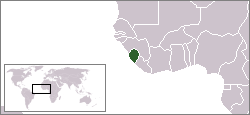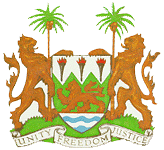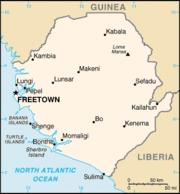Sierra Leone
|
|
The Republic of Sierra Leone is a country in West Africa, on the coast of the Atlantic Ocean. The country is bordered by Guinea in the north and Liberia in the southeast.
| |||||
| National motto: Unity - Freedom - Justice | |||||

| |||||
| Official language | English | ||||
| Capital | Freetown | ||||
| President | Ahmad Tejan Kabbah | ||||
| Area - Total - % water | Ranked 116th 71,740 km? 0.2% | ||||
| Population - Total (2000) - Density | Ranked 102nd 5,426,618 76/km? | ||||
| Independence | April 27, 1961 | ||||
| Currency | Leone | ||||
| Time zone | UTC | ||||
| National anthem | High We Exalt Thee, Realm of the Free | ||||
| Internet TLD | .sl | ||||
| Calling Code | 232 | ||||
| Contents |
History
Main article: History of Sierra Leone
The written history of Sierra Leone begins in 1462, when Portuguese explorers first landed and named the country "Lion Mountains". Europeans used the land as a source for slaves, but in 1787 Freetown was established as a city for former slaves living in London.
In 1808, Sierra Leone became a British Crown Colony, which it remained until halfway through the 20th century, when the process of de-colonisation was commenced. This culminated in independence on April 27, 1961. Sir Milton Margai (1895-1964) was its first prime minister.
The republic—briefly a one-party state in the early 1980s—became involved in a civil war in 1991, with the Revolutionary United Front (RUF) of Foday Sankoh rebelling against the government. This resulted in tens of thousands of deaths and the displacement of more than 2 million people (well over one-third of the population) many of whom are now refugees in neighboring countries. A military coup on May 25, 1997 replaced then President Ahmad Tejan Kabbah with Major Johnny Paul Koromah. Kabbah was reinstated in March 1998, after the junta was ousted by the Nigerian-led ECOMOG forces.
A peace agreement, signed on July 7, 1999 in [[Lomé, Togo offered a slight hope that the country will be able to terminate the diamond-powered conflict, and rebuild its devastated economy and infrastructure. As of late 1999, up to 6,000 UNAMSIL peacekeepers were in the process of deploying to bolster the peace accord.
In May 2000, the situation in the country deteriorated to such an extent that British troops were deployed in Operation Palliser to evacuate foreign nationals. They stabilised the situation, and were the catalyst for a ceasefire and ending of the civil war.
Although there has been a significant amount of news coverage of the war in Sierra Leone, a comprehensive review of the conflict based on extensive field research—using a methodology known as Conflict Mapping—is available here (http://www.specialcourt.org/Outreach/ConflictMapping/NPWJ_CMR_ES_10MAR04.zip).
Politics
Main article: Politics of Sierra Leone
The head of state and government is the president, who is elected every five years (most recently in May 2002). He appoints and heads a cabinet of ministers. The Sierra Leonean parliament is unicameral, with 124 seats. 112 members are elected concurrently with the presidential elections; the other 12 seats are filled by a paramount chief from each administrative district.
Provinces
Main article: Provinces of Sierra Leone
Sierra Leone is divided into three provinces and one district:
Geography
Main article: Geography of Sierra Leone
Much of Sierra Leone's coastline consists of mangrove swamps, with the exception of the peninsula on which the capital city Freetown is located. The rest of Sierra Leone is mostly plateau (about 300 m above sea level) covered by forests, with mountains in the east of the country (highest point Loma Mansa, 1,948 m). The climate is tropical, with a rainy season from May to December.
Major cities are the capital Freetown, Koidu (Sefadu), Bo, Kenema and Makeni.
Economy
Main article: Economy of Sierra Leone
Sierra Leone is an extremely poor nation with tremendous inequality in income distribution. It does have substantial mineral, agricultural, and fishery resources. However, the economic and social infrastructure is not well developed, and serious social disorders continue to hamper economic development, following a 10-year civil war. About two-thirds of the working-age population engages in subsistence agriculture. Manufacturing consists mainly of the processing of raw materials and of light manufacturing for the domestic market. There are plans to reopen bauxite and rutile mines shut down during the conflict. The major source of hard currency consists of the mining of diamonds. The fate of the economy depends upon the maintenance of domestic peace and the continued receipt of substantial aid from abroad.
Demographics
Main article: Demographics of Sierra Leone
There are about 20 different tribes living in Sierra Leone, which together make up about 90% of the population. The most important tribes are the Temne (mostly in the north) and Mende (central and south), both forming about one third of the population. There is a sizeable number of Creoles, descending from enslaved Africans, Asians stranded in London and other Londoners who established a colony there in the 1780s.
Although English is the official language, it is understood by only a minority, as most people speak their tribe's own language. The creole language Krio, based on English, is however spoken by most of the population. The predominant religion is Islam (about 60%), the remainder practice indigenous beliefs or Christianity.
Sierra Leone is the worst nation for childbirth in the world, having the highest Maternal Mortality Ratio, or risk of maternal death, of any country. The MMR of Sierra Leone according to a report from the World Health Organization in the year 2000 is 2,000 maternal deaths per live 100,000 births. The extremely high MMR is principally due to severe obstetric situations such as hemorrhage, obstructed labor, ectoptic gestation, abortion, and puerperal sepsis. Those situations were aggravated by the rebellion and the detrimental effects on distribution of reproductive health services due to the massive displacement of people, destruction of medical infrastructure and hospital equipment, rural inaccessibility, poor and disadvantageous accessibility to basic medical services.
Culture
Main article: Culture of Sierra Leone
Miscellaneous topics
- Heads of Government of Sierra Leone
- Communications in Sierra Leone
- Transportation in Sierra Leone
- Military of Sierra Leone
- Foreign relations of Sierra Leone
External links
Government
- The Republic of Sierra Leone (http://www.statehouse-sl.org/) official government site
News
- allAfrica.com - Sierra Leone (http://allafrica.com/sierraleone/) news headline links
Overviews
- BBC News Country Profile - Sierra Leone (http://news.bbc.co.uk/1/hi/world/africa/country_profiles/1061561.stm)
- CIA World Factbook - Sierra Leone (http://www.cia.gov/cia/publications/factbook/geos/sl.html)
Directories
- LookSmart - Sierra Leone (http://search.looksmart.com/p/browse/us1/us317836/us317916/us559898/us559899/us10065674/us559953/) directory category
- Open Directory Project - Sierra Leone (http://dmoz.org/Regional/Africa/Sierra_Leone/) directory category
- Stanford University - Africa South of the Sahara: Sierra Leone (http://www-sul.stanford.edu/depts/ssrg/africa/sierra.html) directory category
- The Index on Africa - Sierra Leone (http://www.afrika.no/index/Countries/Sierra_Leone/) directory category
- University of Pennsylvania - African Studies Center: Sierra Leone (http://www.sas.upenn.edu/African_Studies/Country_Specific/S_Leone.html) directory category
- Yahoo! - Sierra Leone (http://dir.yahoo.com/Regional/Countries/Sierra_Leone/) directory category
Tourism
- Template:Wikitravel
- National Tourist Board of Sierra Leone (http://www.welcometosierraleone.org/) official site
Other
- Sierra Leone Web (http://www.sierra-leone.org)
- UNAMSIL (http://www.un.org/Depts/dpko/unamsil/body_unamsil.htm)
- Photos: People of Sierra Leone (http://public.fotki.com/sierraleone/sl_series/people_of_sierra_leone/)
- Visit Sierra Leone (http://www.visitsierraleone.org) travel and tourism information
- Dossier about Sierra Leone from Freedomhouse.org (http://www.freedomhouse.org/research/freeworld/2003/countryratings/sierra-leone.htm)
- Cry Freetown (http://www.cryfreetown.org)
- War Crimes Trials in Sierra Leone (http://www.sc-sl.org)
- No Peace Without Justice in Sierra Leone (http://www.npwj.net)
- Sierra Leone Encyclopedia 2004 (http://www.daco-sl.org/encyclopedia2004/index.htm)
| Countries in Africa | ||
|
Algeria | Angola | Benin | Botswana | Burkina Faso | Burundi | Cameroon | Cape Verde | Central African Republic | Chad | Comoros | Democratic Republic of the Congo | Republic of the Congo | Côte d'Ivoire | Djibouti | Egypt | Equatorial Guinea | Eritrea | Ethiopia | Gabon | The Gambia | Ghana | Guinea | Guinea-Bissau | Kenya | Lesotho | Liberia | Libya | Madagascar | Malawi | Mali | Mauritania | Mauritius | Morocco | Mozambique | Namibia | Niger | Nigeria | Rwanda | São Tomé and Príncipe | Senegal | Seychelles | Sierra Leone | Somalia | Somaliland | South Africa | Sudan | Swaziland | Tanzania | Togo | Tunisia | Uganda | Zambia | Zimbabwe | Western Sahara | ||
| Dependencies: Canary Islands | Ceuta and Melilla | Madeira Islands | Mayotte | Réunion | Saint Helena and dependencies | ||



